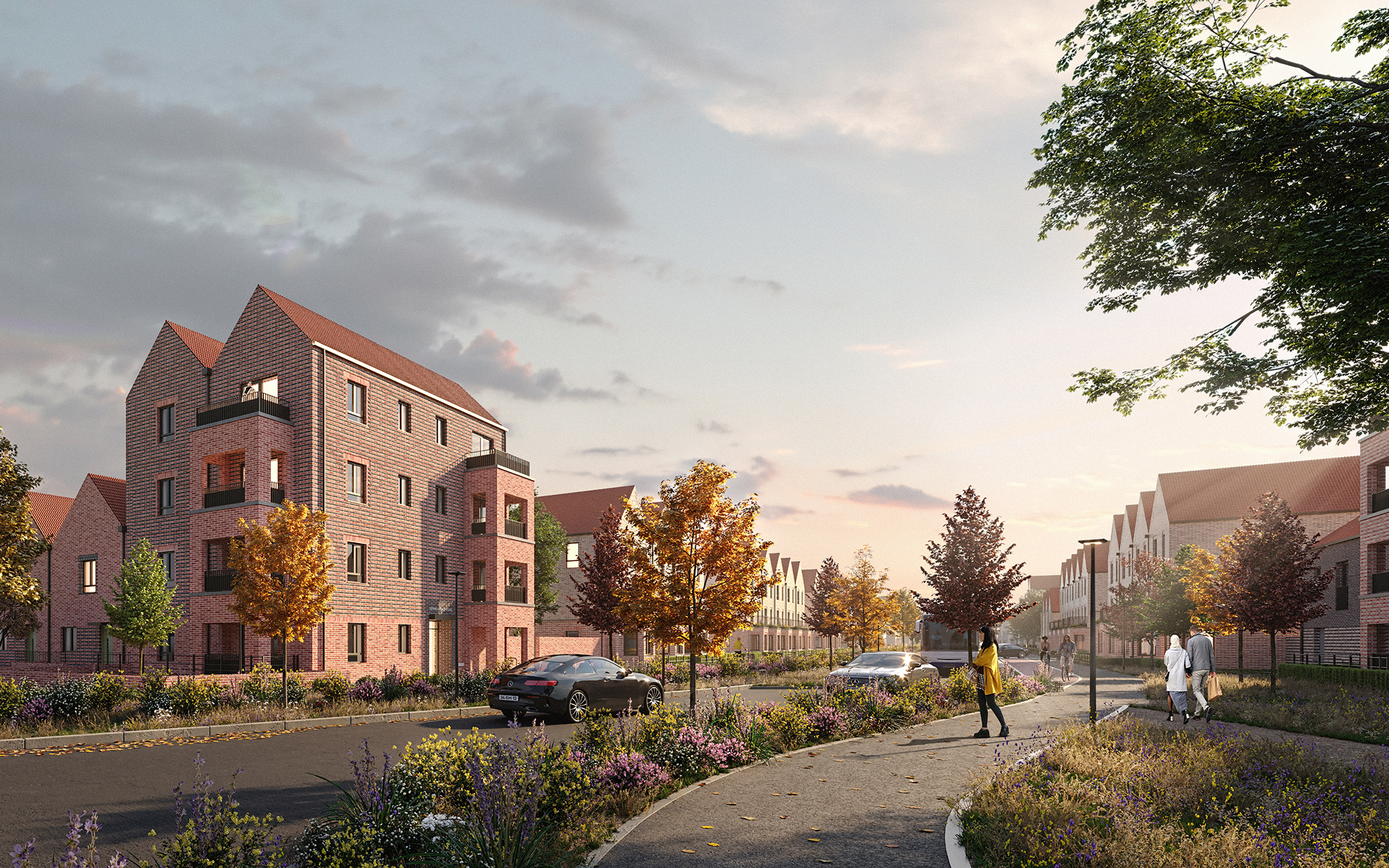
The Cherry Hinton Design Code provides a blueprint for housebuilder development that is less car focussed, and more walkable, sociable, greener, and energy efficient.
Location
Cherry Hinton North lies on the eastern urban fringe of Cambridge, around 2.5 miles from the city core. Its development is part of the City’s long planned eastward expansion, and received outline planning approval in 2020. Although it is a greenfield site, it is adjacent to Cambridge Airport airfield, resulting in soil contamination and poor farmland.
As part of its expansion, the City anticipates that Cambridge Airport will be closed and redeveloped in future, and it was important that our Code allowed for future and set a good precedent for it.
The proposed new site is going to provide 2 new schools, a new local centre, and 1200 new homes.

How we wrote The Cherry Hinton Code
The Code was written over a period of eight months, using frequent structured workshops that tracked the development of the document. PTE and McGregor Coxall, the landscape architects for the code, worked together to ensure an integrated coding approach. A multidisciplinary consulting group was established, with representatives from both the local authority, county, and client, and maintaining that group throughout helped deliver consistency and consensus. A key move was to start with an away-day for all the consulting group to visit recently completed local projects that had used design codes. This built relationships and a shared appreciation of what a good result looks like, and the challenges we might meet delivering it.
We needed the code to be easy to use and concise. We used colour coding for text and diagrams for each document section, and these were based on the colours of the National Model Design Code. We knew how easy it was for guidance documents to grow unwieldy, so it was important that got agreement at the outset that the Code be limited to around 100 pages.
Once completed, we made sure the document was accessible both digitally and printed. The finished document was formally tested with an accessibility audit prior to issue.

Challenges
The outline approval gave us a strong foundation to work from, but also left some key challenges for the coding process to answer.
We used the Design Coding process to take the opportunity to refine the design. This was founded on building collaborative, trusting, relationships. To do this in practice, a section 73 process of minor amendments tracked alongside the development of the code, picking up where changes to parameter plans and conditions would be needed to reflect the code.
Many of the conversations we had were very detailed, but there were some headline changes that made a big difference to the outcome:
There was a planned through-traffic primary route through the site, and this needed to be balanced with provide a safe and attractive environment for the new homes and facilities. This was particularly within the local centre, where the road would isolate the primary school from local green space and facilities. The route was revised to improve the local centre for connections between the school, community, retail uses, and the village green.
Most of the design focus of landscape design had been at the edges, leaving green spaces further within the site feeling more fragmented. Green space parameter plans were altered, including adding a car free green route “The Ridgeway” to connect existing Cherry Hinton residents with the new secondary school.
Sustainable energy and energy saving objectives were relatively modest, albeit with a percentage of exemplar homes required as part of the S106. By omitting the “exemplars” we were able to agree uplifting all homes to 70% over part L

What the completed Code does
The Code sets benchmarks for quality, strategic, sustainable, placemaking. It covers the important things that planning rules on their own can’t - holistic sustainability, urban design principles, a sense of occasion, and networks of connection. While the Code reflects planning rules, it is careful not to duplicate them unless we thought it was helpful.
The Code follows the government’s National Model Design Code, which identifies 10 Characteristics of Place. We wanted to ensure that these different characteristics weren’t tackled in isolation, but instead as interconnected components of a good place, and to do this we grouped these 10 characteristics into two structured groups: Living Infrastructure brings together Public Space, Movement, Nature and use of resources. Living Communities combines themes of building design and use.
Through Living Infrastructure, rather than creating cul-de-sacs, a framework for well-connected networks of streets and green spaces is established. The streets are coded as public spaces with low speeds, trees, and regular focal points including “play on the way”. An important local community is to create a through traffic route on the site, diverting traffic from existing streets, and the new route incorporates bus stops, separate cycle paths, and extensive natural suds and trees. Other streets are traffic restricted or wholly traffic free. We worked closely with the local authority to ensure streets and spaces can be adopted, containing future management costs for residents.
In Living Communities, the code for buildings focusses on their role in creating effective and sociable street frontages, marking movement and meeting points with satisfying focal points. Material palettes, and detail design guidance for windows, doors, and services (including do’s and don’ts) are also included. The number of character areas were kept to 3, helping give more focussed guidance, with the differences described as distinct density ranges and rural, suburban villa, and urban terrace typologies.

Testing the Code
Once the detail draft was complete the team conducted a “road test” for the Code. 3 external design teams were recruited to test the code on key areas of the site. These teams represented different strands of the industry, from housebuilding architects through to small award-winning practices. Their feedback was very positive, but also included helpful criticisms and observations which helped us produce the final revised version of the Code.
A key outcome of testing the Code was thinking more about how it would be used by the planning team to assess the future planning applications. We subsequently developed a useful checklist, not uncommon, but ours also provides guidance on how to show compliance, rather than just a “tick box”.
Reception and Use
The Cherry Hinton Design Code has been a widely welcomed document and was positively engaged with by the surrounding Parish Councils and community. The Code received unanimous approval at committee, with the chair describing it as an exemplar document and the best code he had seen. The planners have described the code as “a high-quality, well-structured document that clearly and systematically establishes the key elements that will contribute to high quality placemaking”.
The Design Code has now been used to guide 3 subsequent reserved matters applications for both infrastructure and the first 350 homes – in which role it has been vital.

Key Features
- Delivers energy efficiency with volume housebuilding. 70% improvement over Part L, and 100% of all houses and around 95% of all flats as “dual aspect”.
- Living Infrastructure, which makes networks of green spaces, SUDs, street trees, and traffic free green streets. 1Ha additional greening is added through the creation of traffic-free green routes.
- Walkable neighbourhoods promoting active travel. Green spaces are within 1-2 minutes of all homes, and the market square with shops, primary school and community facilities less than 10 minutes’ walk away via quiet streets and green routes.
- Play-on-the-way. Incidental play and resting spaces incorporated into the design of streets and pocket spaces
- Affordability. The code minimises ongoing resident costs by maximising adoption of streets and green spaces.




